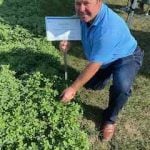Manitoba farmers could find themselves between a rock and a hard place
when it comes to dealing with fusarium-infected cereal crops this year.
A common practice for dealing with infected crops is to set the combine
so the lighter infected kernels are blown out the back of the combine.
It can help improve the grade of crops tainted with the disease.
But researchers have discovered that infected grain kernels blown back
onto the field could be a greater menace than previously suspected.
Read Also

Agriculture ministers commit to enhancing competitiveness
Canadian ag ministers said they want to ensure farmers, ranchers and processors are competitive through ongoing regulatory reform and business risk management programs that work.
“You may be getting rid of it from the harvested grain, but you’re not
getting rid of it from the field,” said Andy Tekauz of Agriculture
Canada’s Cereal Research Centre in Winnipeg.
Research has revealed that the fungus can survive on infected kernels
for up to two years, Tekauz said. Those kernels increase the risk of
infection in succeeding years.
Researchers used to think the small, infected kernels broke down more
quickly in the field after harvest, providing only a brief host for the
fusarium to survive on.
Tekauz said they now know the fungus can survive for years, even if the
host kernels are tilled into the soil following harvest.
However, unless the kernels are returned to the surface, they won’t
release the inoculum, he said.
Fusarium can lower grain yields and quality. In high enough levels, it
can render barley unsuitable for malting or for livestock feed.
Surveys determining the prevalence of the disease in this year’s crops
were not yet complete last week. There’s concern, however, that much of
Manitoba’s cereal crop was again infected due to a bout of moisture and
high humidity.
To prevent blowing infected grain out the back of a combine, Manitoba
plant pathologist David Kominski said one option is to capture the
seeds in a chaff saver.
The chaff pile can then be removed from the field or burned.
Equipment such as the McLeod Harvester could be another option,
Kominski said. With the McLeod system, a pull-type harvester collects
the grain, chaff and weed seed from the field. The grain is then hauled
to a cleaning mill that separates the grain and processes the chaff and
weed seed into livestock feed.
While infected seed released onto a field during harvest can add to the
fusarium problem, Kominski suggested that a greater concern remains in
the straw stubble, where the inoculum also can reside.
“That’s probably much more important than grain laying on the surface.”














